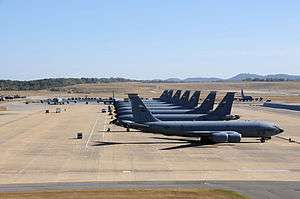Birmingham Air National Guard Base
| Birmingham Air National Guard Base | |
|---|---|
| Part of Alabama Air National Guard (AL ANG) | |
| Located near: Birmingham, Alabama | |
|
KC-135s of the 117th Air Refueling Wing on Birmingham Flightline | |
| Coordinates | 33°33′50″N 086°45′08″W / 33.56389°N 86.75222°W |
| Site information | |
| Controlled by |
|
| Site history | |
| Built | 1942 |
| In use | 1942-Present |
| Garrison information | |
| Garrison |
 117th Air Refueling Wing |
| Airfield information | |||||||||||||||
|---|---|---|---|---|---|---|---|---|---|---|---|---|---|---|---|
| IATA: BHM – ICAO: KBHM – FAA LID: BHM | |||||||||||||||
| Summary | |||||||||||||||
| Elevation AMSL | 271 ft / 83 m | ||||||||||||||
| Coordinates | 33°33′50″N 086°45′08″W / 33.56389°N 86.75222°WCoordinates: 33°33′50″N 086°45′08″W / 33.56389°N 86.75222°W | ||||||||||||||
| Map | |||||||||||||||
 KBHM Location of Birmingham Air National Guard Base | |||||||||||||||
| Runways | |||||||||||||||
| |||||||||||||||
| Statistics (2009) | |||||||||||||||
| |||||||||||||||
- See: Birmingham-Shuttlesworth International Airport for civil airport information
Birmingham Air National Guard Base is the home of the United States Air Force 117th Air Refueling Wing.
Overview
Birmingham ANGB consists of approximately 147 acres and essential facilities to support the mission of the 117th Air Refueling Wing and its assigned units.[3]
The 117th ARW occupies 101 facilities including offices, mission support structures, maintenance hangars, POL storage and refueling station and a Joint Hospital. As of 2002 the Wing had 9 authorized KC-135 Stratotankers. The current complement of personnel is 275, including military and civilian employees. This expands to 1,243 personnel for UTA weekends and during activation.[3]
The Alabama Army National Guard (ARNG) has facilities and units co-located on the base. These facilities provide for aircraft hangar and maintenance, the 109th Evacuation Hospital and OMS storage facility. The 109th Evac Hospital also supports ARNG/ANG weekend drill activities and unit activation's. In addition, the Federal Aviation Administration has two radar sites within the confines of the base[3]
History
World War II
The airport was opened in April 1940 as Birmingham Municipal Airport, and was the commercial airport for Birmingham, Alabama. During World War II the airfield was leased by the United States Army Air Forces for $1.00/year and it became a joint Civil Airport/Military Airfield, being designated as Birmingham Army Air Base.
Birmingham AAB was initially used by 3d Air Force as a staging airfield for combat units prior to their deployment to overseas combat theaters. The XII Tactical Air Command was formed at Birmingham AAB on 10 September 1942. On 16 April 1944, Birmingham AAB was transferred from 3d Air Force to Air Technical Service Command with Joint Use by Air Materiel Command and Air Transport Command. Materiel and Technical Service Commands used the base as a major aircraft modification center and air depot under the Mobile Air Materiel Area (MOAMA). Transport Command operated large numbers of cargo and passenger aircraft from the base as part of its Domestic Wing.
In 1948 the airport was returned to civil control.
Alabama Air National Guard
In 1946 the 106th Reconnaissance Squadron (Bomb) and the 160th Fighter Squadron, flying F-51s were assigned together to the 117th Fighter Group, which later became the Alabama Air National Guard 117th Tactical Reconnaissance Group and established its headquarters on 31 March 1946 at Birmingham AAB. It was Federally recognized on 26 November 1946.
In the present day, the Air National Guard has a base which includes nine KC-135R Stratotanker aircraft assigned to the 117th Air Refueling Wing (117 ARW), an Air Mobility Command (AMC)-gained unit of the Alabama Air National Guard. The 117 ARW was previously designated as the 117th Tactical Reconnaissance Group (117 TRG) and later as the 117th Tactical Reconnaissance Wing (117 TRW), a Tactical Air Command (TAC) / Air Combat Command (ACC)-gained unit operating the RF-4C Phantom II reconnaissance aircraft. [3] A lease between the Federal Government and The Armory Commission of Alabama, dated 22 January 1961, currently with four Supplemental Agreements, established the initial boundaries and conveyed the lands and buildings for the purpose of military aviation. A Lease Amendment between the Birmingham Airport Authority and the Commission in 1988 established the real estate relationship between the airport authority and the Armory Commission. The lease term expires in the year 2036 but shall continue year to year without notice unless terminated by the Commission.[3]
Prior to 1996, the base was bisected by two city streets - East Lake Blvd and Shelby Blvd. As a part of the Master Plan update, East Lake Blvd was rerouted around the base perimeter, Shelby Blvd was transferred to the ANG with a lease amendment, and the individual land parcels were consolidated into one tract of land. This consolidation greatly improved internal traffic circulation, security and unit operations. Prior to the road relocation, this area was in a municipal environment with the utilities routed along the city street easements and rights of way. Electric service was initially supplied by overhead wires and buildings individually metered for consumption and billing. This was changed recently to economize energy costs by establishing with the utility a main feeder with a single primary meter. The ANG provides secondary distribution to the on-base facilities through a system of underground conduits. The overhead wiring remains in service to provide electrical service for street lights and other units occupying the base.[3]
In September 1994, the 117th Air Refueling Wing and 106th Air Refueling Squadron were formed and equipped with KC-135 tanker aircraft. Simultaneously, a major revision outlined in the Base Master Plan was initiated to complete improvements in the infrastructure to support the new mission, to unify the existing real estate holdings into one contiguous environ and to implement facility improvements and additions necessary to support the mission. The Master Plan recommendations included the relocation of a city thoroughfare, consolidation of three real estate parcels and the completion of almost $64 million in facility improvements and construction. To date, all but one of the recommended projects are complete, and it is in the final stages of design.[3]
See also
References
![]() This article incorporates public domain material from websites or documents of the Air Force Historical Research Agency.
This article incorporates public domain material from websites or documents of the Air Force Historical Research Agency.
- ↑ FAA Airport Master Record for BHM (Form 5010 PDF), effective 2008-09-25.
- ↑ BHM Statistical Reports. Birmingham Airport Authority Official Site.
- 1 2 3 4 5 6 7 117th Airlift Wing website
| ||||||||||||||||||||||||||||||||||||||||||||||||||||||||||||||||||||
| ||||||||||||||||||||||||||||||||||


.svg.png)